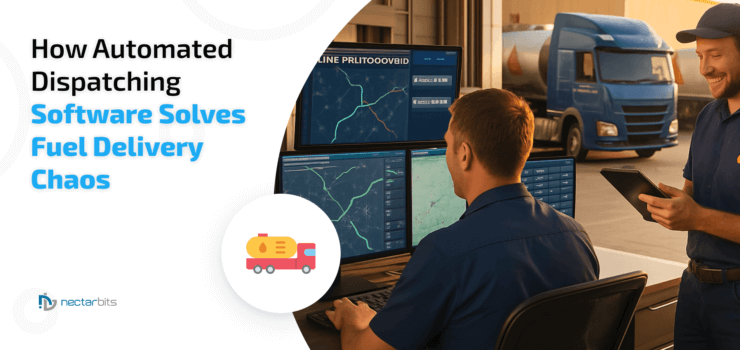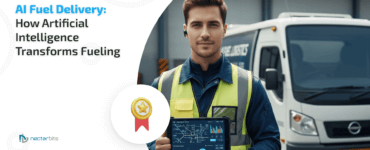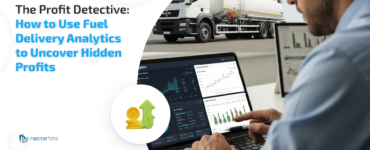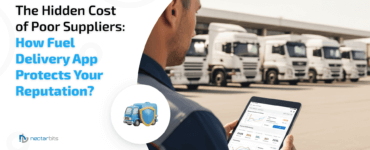Fuel delivery is a critical service that keeps industries, businesses, and households running smoothly. However, managing fuel delivery operations can be a logistical nightmare. From scheduling conflicts to route optimization challenges, the chaos can lead to delays, increased costs, and dissatisfied customers.
Automated dispatching software offers a solution to these challenges, revolutionizing the way fuel delivery is managed.
Statistical Insights on Fuel Delivery Sector
Mobile Fuel Delivery Market
- 2025 Market Size: USD 5.84 billion
- 2035 Projected Size: USD 11.93 billion
- Compound Annual Growth Rate (CAGR, 2025–2035): 7.4%
- Diesel Share (2025): 62% of market
- Growth Drivers: Demand for convenience, on-demand services, and urban fleet operations. Adoption of mobile apps, GPS tracking, and automated payments is increasing operational efficiency and customer satisfaction.
Doorstep Fuel Delivery Market
- 2024 Market Size: USD 0.89 billion
- 2025 Projected Size: USD 1.0 billion
- 2033 Projected Size: USD 2.46 billion
- CAGR (2025–2033): 11.6%
- Main Factors: Rapid urbanisation, increased vehicle usage, demand from logistics, construction, and agriculture sectors. The market is being driven by both B2B and B2C segments, and is expanding into sustainable fuels like biofuels and EV charging.
Fuel Delivery System (General)
| Year | Market Size (USD Billion) | CAGR | Notes |
|---|---|---|---|
| 2024 | 4.8 | ||
| 2025 | 5.2–10.6 | 4.8–8.6% | Estimates vary based on market segment |
| 2031 | 7.2 | 8.6% | Estimates vary based on the market segment |
| 2033 | 8.1–8.5 | 7% | Wider estimates include advanced system sales |
| 2035 | 16.9 | 4.8% | Automotive fuel delivery systems only |
What is Automated Dispatching Software?
Automated dispatching software is a digital platform that streamlines the scheduling, routing, and tracking of fuel deliveries using automation and real-time data.
Core Features and Components
Most platforms include:
- Route optimisation algorithms
- Real-time vehicle tracking (GPS integration)
- Automated scheduling and dispatching
- Communication tools for drivers
- Reporting dashboards
- Description: These features ensure seamless and efficient dispatch operations.
Integration with Existing Systems
Top-tier dispatching solutions easily integrate with fleet management software, CRM systems, fuel inventory tools, and even customer billing platforms, creating a seamless tech ecosystem.
Cloud-Based vs On-Premise Systems
Cloud-based systems offer flexibility, scalability, and remote access—ideal for modern, mobile-first teams. On-premise options may offer more control but often lack agility.

Major Problems in Fuel Delivery Chaos
Here are the primary issues companies face without automation:
Delayed Deliveries
Unexpected traffic, bad weather, or driver no-shows? Without a dynamic system, re-routing is sluggish—leading to costly delays.
Poor Route Optimisation
Manual planning often overlooks real-time data like traffic or fuel levels, resulting in inefficient routes and wasted fuel.
Miscommunication Between Drivers and Dispatchers
Without centralised platforms, drivers and dispatchers are often out of sync—leading to wrong deliveries, missed stops, or redundant trips.
How Automation Addresses Fuel Delivery Chaos
Real-Time Tracking and Route Planning
Automated dispatching software uses GPS and predictive traffic data to optimize routes dynamically. When conditions change, drivers are automatically rerouted in real time.
Automated Notifications and Alerts
Customers get real-time ETA updates, while dispatchers receive alerts if delays or exceptions occur—minimizing guesswork.
Smarter Resource Allocation
Automated systems can assign the nearest available and qualified driver to a job, reducing idle time and maximizing output.
Benefits of Using Automated Dispatching Software
Increased Operational Efficiency
Tasks that once took hours—like route planning or dispatch—are completed in minutes. The software eliminates repetitive tasks and enables scaling without proportional workforce increases.
Enhanced Customer Satisfaction
Accurate ETAs, faster deliveries, and fewer mistakes mean happier clients who are more likely to remain loyal.
Reduced Fuel and Labour Costs
Better routes and optimized loads save on fuel, while automation reduces the need for excessive staffing.

Case Study: Fuel Company Before and After Automation
Initial State of Operations
ABC Fuel Co. was managing over 200 deliveries a week using manual spreadsheets and whiteboards. Missed deliveries and route inefficiencies were the norm.
Implementation Process
Within a month of integrating an automated dispatching system, the team underwent onboarding, synced inventory and vehicle data, and rolled out mobile apps to drivers.
Measured Improvements
- Delivery delays dropped by 47%
- Fuel usage reduced by 18%
- Customer satisfaction scores rose by 31%
Real-Time Data and Analytics
Leveraging Predictive Insights
The software not only reacts—it predicts. Companies can forecast delivery bottlenecks, high-demand zones, and driver performance trends.
Reporting Dashboards for Decision-Making
Managers get a bird’s-eye view of operations, with KPIs like delivery accuracy, average route time, and vehicle utilization front and center.
Safety and Compliance Made Easier
Automated Logs and Digital Documentation
Gone are the days of manually keeping driver logs or delivery records. Automated dispatching software generates digital logs, ensuring accuracy and eliminating paperwork errors. This also makes audits and compliance checks far less stressful.
Regulatory Compliance Tracking
The system can be configured to monitor compliance with DOT regulations, environmental policies, and fuel transport safety standards. Alerts are sent if any parameter is out of range—helping companies remain compliant without extra effort.
Integration with IoT and Telematics
Real-Time Vehicle Diagnostics
Modern dispatch software often connects with telematics systems to pull data directly from vehicles. Dispatchers can monitor engine health, tire pressure, and maintenance needs—reducing breakdowns and service disruptions.
Fuel Level Monitoring and Asset Tracking
IoT sensors in tanks and trucks can track fuel levels, temperatures, and location. This ensures timely refills, reduces pilferage, and improves inventory management across the supply chain.

Mobile App Features for Field Personnel
Easy Job Dispatch and Completion
Mobile apps allow drivers to receive jobs, update statuses, and log deliveries in real-time. Everything is accessible via smartphones or tablets—no more paper tickets or unnecessary calls.
Communication and Photo Proof Uploads
Drivers can communicate instantly with dispatchers, send delivery confirmations, and even upload photos of completed drops—adding an extra layer of transparency and accountability.
Environmental and Sustainability Gains
Less Idling and Optimized Routing
With smart route planning, trucks spend less time idling or taking long detours. This reduces overall fuel consumption and carbon emissions—good for the planet and your budget.
Lower Carbon Emissions
Reducing fuel waste directly cuts down on CO2 output. Many companies use these metrics to support green certifications and sustainability reports.
Cost-Benefit Analysis of Automated Dispatching
Initial Investment vs Long-Term ROI
While there is an upfront cost to implementing automated dispatching software, the long-term savings on fuel, labor, and delivery efficiency often offset this within 6 to 12 months.
Quantifying Efficiency Gains
- 20–30% reduction in dispatching time
- Up to 25% drop in missed or delayed deliveries
- ROI of 200–300% within the first year in many cases
Choosing the Right Software Vendor
Key Features to Consider
Look for:
- Scalable architecture
- Real-time GPS integration
- Easy onboarding and training
- Mobile app support
- Customizable alerts and reporting tools
- Description: These features ensure seamless and efficient dispatch operations.
Vendor Reputation and Support
Choose vendors with proven industry experience and 24/7 customer support. Check reviews, ask for case studies, and test demos before committing.
Future Trends in Dispatch Automation
- AI-driven dispatch optimization: Artificial intelligence is now central to route planning, demand forecasting, and resource allocation, allowing for smarter and faster dispatch decisions while improving accuracy over time through continuous learning.
- Hyperautomation and robotics: Widespread deployment of automated systems, including robots and autonomous vehicles, accelerates dispatch processes, reduces human error, and enables personnel to focus on higher-value tasks.
- Real-time visibility using IoT and digital twins: IoT sensors and digital twin technologies provide end-to-end tracking and simulation, ensuring dispatchers have up-to-the-minute data on vehicle location, status, and conditions to proactively address disruptions.
- Voice-based and hands-free command systems: Advanced dispatch platforms now support voice assistants, allowing dispatchers to assign routes, communicate with drivers, and review schedules more efficiently and safely, especially in high-pressure environments.
- End-to-end ecosystem integration: Dispatch systems are being tightly integrated with supply chain, inventory, and customer service platforms by leveraging APIs and cloud technologies, resulting in faster, seamless information flow and coordinated actions.
- Increased adoption of autonomous vehicles and drones: Automated vehicles and drone deliveries are streamlining last-mile dispatches, reducing delivery time and operational costs, and facilitating service in hard-to-reach areas.
- Sustainability-driven dispatch models: Emerging tools focus on carbon footprint reduction—optimizing routes for fuel efficiency, leveraging electric fleets, and aligning with broader corporate sustainability goals.
- Predictive and prescriptive analytics: Dispatch automation is evolving from reactive problem-solving to anticipating and preventing issues before they occur, thanks to AI-powered predictive analytics that analyze vast datasets in real time.
These trends encapsulate the shift toward a fully digitized, intelligent, and adaptive dispatch ecosystem as logistics faces greater complexity and customer demands in 2025.

Common Myths About Dispatch Automation
Is It Too Expensive?
No. The initial cost is often outweighed by fuel savings, reduced labor costs, and higher delivery accuracy.
Will It Replace Human Dispatchers?
Not at all. It empowers dispatchers to be more strategic and less bogged down in routine tasks.
Is It Hard to Implement?
Most modern systems are user-friendly and come with onboarding support. With proper training, teams can be up and running in days.
Conclusion
Automated dispatching software is a game-changer for the fuel delivery industry. By addressing the chaos and inefficiencies in traditional delivery methods, it empowers businesses to deliver better services, reduce costs, and stay ahead in the market.
Investing in automated dispatching software is not just a choice; it’s a necessity for businesses aiming to thrive in the modern era.
FAQ
Automated dispatching software is a digital tool that uses automation and real-time data to streamline scheduling, routing, and tracking of deliveries.
It optimises routes, automates scheduling, provides real-time tracking, and enhances communication between drivers and dispatchers.
Yes, many solutions are scalable and cater to businesses of all sizes.
It reduces fuel consumption, minimises delays, and lowers operational costs, offering a high ROI.
Most systems can be implemented within a few weeks, depending on the complexity of operations.
No, modern systems are user-friendly and come with training and support.
Yes, top-tier solutions integrate seamlessly with fleet management, CRM, and billing systems.
Optimised routing reduces fuel consumption and carbon emissions, supporting sustainability goals.
Reputable vendors offer 24/7 support to ensure smooth operations.
The software tracks regulatory requirements and generates automated logs to simplify compliance.







